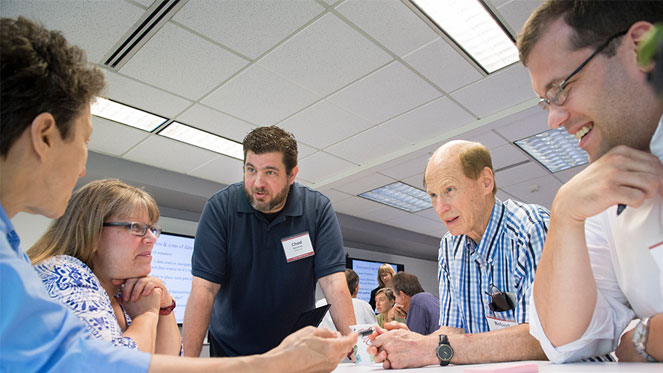Eberly Center’s First Teaching Institute Already Impacting Classrooms

Students learn by doing, and despite an overwhelming amount of evidence supporting this, questions remain about how exactly instructors should implement active learning activities into their classrooms.
To show Carnegie Mellon University faculty how to successfully integrate active learning or enhance what they are already doing, the Eberly Center for Teaching Excellence and Educational Innovation held a three-day institute last summer on "Teaching as Research." And instead of just handling over ideas or tools, the Eberly Center focused on how instructors can use their classrooms as learning experiments by collecting data and using it to then go back and re-tool how the activities are used.
This continuous quest to improve teaching and learning based on data is a hallmark of both the Eberly Center and the university’s Simon Initiative.
"We have a faculty community that is hooked on applying scientific approaches to answer questions in their given discipline," said Marsha Lovett, director of the Eberly Center, co-coordinator of the Simon Initiative and teaching professor of Psychology. "We are showing them how to apply the same research mindset to teaching so that they become ‘teacher researchers,’ and they’re in the driver seat collecting data that can inform them about what works best in their classrooms."
Lynne Pastor, associate teaching professor in the Heinz College, spends a considerable amount of time developing and redeveloping courses.
"In the past, I would 'tweak' my classes from instinct, experience in the classroom and some feedback on course evaluations," Pastor said. "However, no matter how experienced and dedicated you are as a teacher, a 'gut' feeling is not a substitute for objective evidence."
Part of the Summer Institute focused on active learning strategies, which engage students as critical thinkers in dialogue with their peers and the instructor—instead of as passive listeners and note takers. Previously, Pastor used this approach in her classes that met twice a week by presenting one session as a traditional lecture and then requiring students to watch videos ahead of the other in order to apply what they learned from both in the second class.
The institute shed light on a different strategy that focused on shorter applications of active learning, such as 15-minute cases and group work activities and then having students discuss their work with each other and the entire class.
"While this seems so obvious now, it was like a light going off in the session. I had always asked questions in class but not taken the step to turn it into an activity," Pastor said.
Following the Summer Institute, DJ Brasier, assistant teaching professor of neuroscience in the Mellon College of Science, decided to measure the impact different learning materials, such as peer reviewed studies and biographies of disease survivors, have on students’ attitudes in his Neurobiology of Disease class. He surveyed the students and asked about their ideas on the scientific process, causes and treatments of different diseases and their enthusiasm for the material.
While the data analysis, with the help of the Eberly Center staff, is still ongoing, Brasier is glad he attended the institute.
"Really, the most valuable thing was vocabulary and conceptualization for things like direct vs. indirect measures and the types of data sources you could use," he said. "Another thing that was really helpful was the information on study designs and their clarification and distinction between 'what is' and 'what causes' studies."
Michael McCarthy, associate teaching professor of information science in the Heinz College, and Joe Mertz, teaching professor of information systems in the Heinz College and Dietrich College of Humanities and Social Sciences, co-teach a large lecture course with a lab. In the past, students have had difficulty applying what they learned in the labs to their answers on exams.
In an attempt to improve exam results, McCarthy and Mertz added a new 10-minute application activity to each lecture following a lab. To evaluate which approach is more effective for learning, they used two different facilitation strategies: (1) debriefing the rationale of the correct answers, versus (2) discussing the rationale behind both correct and incorrect answers. They are eager to see the results so they can adopt the more effective approach it in the next version of the course.
"The workshop really helped with streamlining the IRB process," McCarthy said. "We learned a lot about data sources but also about the active learning approach and ways it can be used in the classroom. It was a very useful, soup-to-nuts, three days."
As the Eberly Center staff continues to work with the faculty to evaluate the data that was collected and determine the next steps for each course, they are already planning a second institute on Teaching as Research. From May 16-18, 2017, they will hold "How Does Active Learning Impact Critical Thinking, Creativity and Innovation?"
"The strength of the institute’s approach is that it meets instructors wherever they are in their interests and skill sets," said Chad Hershock, director of faculty and graduate student programs for the Eberly Center. "You don’t have to be an expert on active learning or educational research methods to benefit. And, instructors are extremely busy, so we offer tangible Eberly support at every step of the process to lower the barriers to adding these approaches to one’s toolkit."
Hershock added, "Fifteen potentially transferable projects resulted from the first institute. I’m excited to see this community of data-informed CMU instructors continue to grow and share their lessons learned."
Learn more about the Eberly Center's next institute.
_____
By Shilo Rea